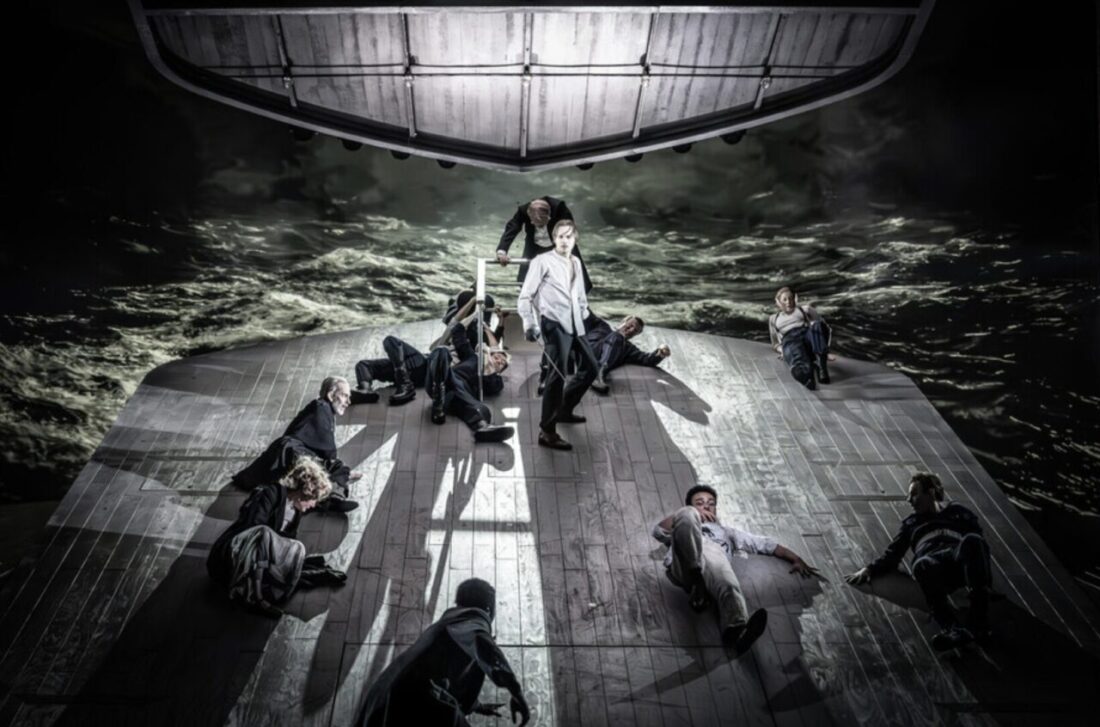

26 February 2025

It’s the Voyage of the Damned as Rupert Goold returns to the RSC for the first time since The Merchant of Venice in 2011. He’s been rather busy since then as the brilliant Artistic Director of the Almeida Theatre in Islington and in 2026 will takeover as Artistic Director at the Old Vic. His other recent triumph outside of his home base was This Is England at both the National Theatre and West End.
Here he has the genius idea to turn Elsinor into an ocean going liner – a ship of state – along the lines of the doomed Titanic, with the cast, in splendid Edwardian clothing (designer Evie Gurney making her RSC debut after Natasha, Pierre and the Great Comet of 1812 at the Donmar Warehouse) wearing life vests that foreshadow the play’s catastrophic climax.
Set Designer Es Devlin has matched that frankly crackpot nautical idea with a massive pointed double height platform that creaks ominously and rises and tilts in alarming fashion – the cast and crew sliding off the deck to their deaths at key moments – with a giant screen behind dividing into horizontal, vertical and giant porthole shaped screens to mark out different cabins and locations aboard, with striking projections of a thrashing dark and gloomy stormy seascape (video design Akhila Krishnan) and massive pumping pistons depicting the very bowels of the engineering deck where stokers toil and bodies are disposed of.
At the start it’s all hands on deck for the pomp and ceremony of the royal burial at sea of the recently deceased monarch, Hamlet King of Denmark, murdered by his brother, Claudius, who then hastily marries Gertrude, the widowed Queen. The ghost of the late King appears on deck like a spectral Ancient Mariner to tell his son Hamlet of the murder most foul, then leads him into the very bowels of the ship, which glow an ominous red. Hamlet swiftly swears revenge and decides to feign madness to cover up his murderous intentions…
Luke Thallon, making a striking RSC debut in his first Shakespeare role, is absolutely mesmerising to watch; delivering one of the truly great Hamlets of our age. His body shaking with involuntary spasms, borderline Tourette syndrome, I thought, he spits, shouting, shrieking, bellowing the text – it’s as if he can’t get the words out quick enough. He places loud emphasis on the oddest of words, yet this conversational way with Shakespeare’s text feels feels 100% authentic and thrilling. No matter how many times you’ve seen Hamlet performed, this psychologically absorbing performance will be a complete revelation. I found myself sitting on the very edge of my seat, not sure what he would say or do next. I absolutely loved his interpretation. Genuine star quality.
The action, staged over a single night in 1912, with time passing signified by a red digital onstage clock – the “witching hour” signalled as 00:00 – is frequently dazzlingly staged. The climactic sword duel between Hamlet and Laertes, after a savage water torture scene with Claudius (Jared Harris) submerging Hamlet’s head repeatedly in a bucket of water to discover the location on the ship of Polonius’s body, takes place on a violently lurching deck, with poison-tipped metal sabres rattling alarmingly in a fast-paced, gung ho, heart-stopping fight scene (fight director Kev McCurdy) reminiscent of Timothy Dalton’s Prince Barin and Sam J Jones as Flash in the film Flash Gordon. My heart was literally in my mouth as the tragic events unfolded.
Among the rest of a strong cast, acting honors go to Nancy Carroll as a feisty, imperious Gertrude, Elliot Levey (also so good in Giant at the Royal Court) who elicits much humour from Polonius, and Anton Lesser as both the Ghost and Player King.
Ship of Fools? This is must-see theatre at its very finest.